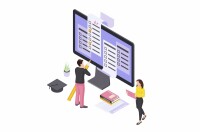Search
There are 34 results.
Category
Tag
Tag
All (34)
Alt Text (2)
Analytics (1)
Assessments (2)
Asynchrony (3)
Backwards Design (1)
Belonging (1)
Canvas (1)
Collaboration (2)
Color Contrast (2)
Communication (5)
Community (3)
Content Creation (2)
Content Delivery (1)
Copyright (1)
Course Maintenance (1)
Course Materials (3)
Course Preparation (3)
Discussions (1)
Diversity (1)
Equity (2)
Faculty Presence (1)
Feedback (1)
Images (1)
Inclusion (2)
Learning Objectives (2)
Multimodality (3)
PowerPoint (1)
Qualitative courses (1)
Quantitative courses (1)
Representation (1)
Rubrics (1)
Screen Readers (1)
Spreadsheets (1)
Summative Assessments (1)
Synchrony (4)
Third-Party Tools (1)
Universal Design for Learning (UDL) (1)
Video (1)
Visual Accessibility (2)
Format
Five Ways to Succeed as an Online Instructor
Whether experienced or new to online teaching, following these tips on online instruction can make the process more intuitive. The online environment may seem vastly different from the classroom, but these tips will make it feel natural, allowing you to improve student experience, increase teaching efficacy, cultivate engagement, and ensure successful course management.
Emergency Course Build Checklist: A Response to COVID-19
Your class was never intended to be online. It was delivered face-to- face to a live audience. Perhaps it followed that same structure for years. Now, with little warning, it’s an online class. Where do you start? What do you prioritize? And what is essential to create a meaningfully engaging learning experience online? Rapidly transitioning a course to online doesn’t require recreating every element of the face-to-face version.
Easy and Essential Online Course Elements
Transferring your course online opens a world of possibilities. In fact, you might be tempted to spend hours trying to locate and learn new educational technologies, or to rebuild your entire course in the learning management system (LMS). But while effective use of technology can certainly enhance learning experiences, it can also introduce obstacles for both faculty and students.
Building Your Online Course With the Lister Model
So, you are building a course for the online environment. What an exciting adventure! When building an online course, you may use a similar method to what you used when developing a course previously, or you may use an entirely new technique. Either option is a good option. But, you may have a few questions when you first begin such as: How do I organize my materials? How do I display my materials? How do I make sure my students work together?
Quizzes for the Multimodal Course
From trivia games to final exams, quizzing tools have a variety of uses for learning as well as assessment. Exams and quizzes have a particularly plentiful range of possibilities in a multimodal or hybrid course, where they can be administered synchronously or asynchronously. Research suggests that the presentation of a tool influences student behavior in response to the tool. In comparing two student discussion boards, one an ungraded discussion and one a graded replacement for a final exam, Cheng et al. (2013) found that students displayed more knowledge on the graded board, but more evidence of learning on the ungraded board. The students who participated in the study were more likely to grapple with new ideas when the stakes were low, but more eager to showcase topics they were confident about when their responses would have a greater impact on their grades. When considering quizzing tools, then, we recommend allowing your course goals to guide your usage.
Inheriting an Online Course
Over the course of your teaching career, you may inherit an online course developed by another faculty member. While such a situation can offer many advantages, it can also provoke many questions and pose significant challenges. Inheriting a complete course with materials and assessments already in place can simplify and streamline some aspects of instruction, but it can be difficult to identify where to start and what to prioritize as you begin engaging with the course. This blog outlines a four-phase process that can lead to a successful transition.
Five Ways to Combat Linguistic Bias in the Classroom
Developments such as the evolution of World Englishes (WE) and African American scholars’ use of African American Vernacular English (AAVE) have opened an important dialogue around academic writing standards, language ownership, and linguistic justice (Canagarajah, 2006; Young, 2010). Authors like Gloria Anzaldua who mix, for example, Native Indian, Spanish, and English in texts, are engaging in the literary tradition of code meshing, which has been shown to facilitate acquisition of English when used by multicultural students in the classroom, according to research (Canagarajah, 2006). By adopting inclusive practices, course designers can combat linguistic bias and promote writing achievement for all learners. This blog contains five recommendations for reducing linguistic bias in online education.
No Sweat Alt Text
What is “alt text”? Alt text is descriptive text linked to an image, graph, or other visual content that allows users to understand the visual without viewing it. Any image online should contain alt text, but guidelines differ depending on whether the image is simply decorative or related to other content on the page.










